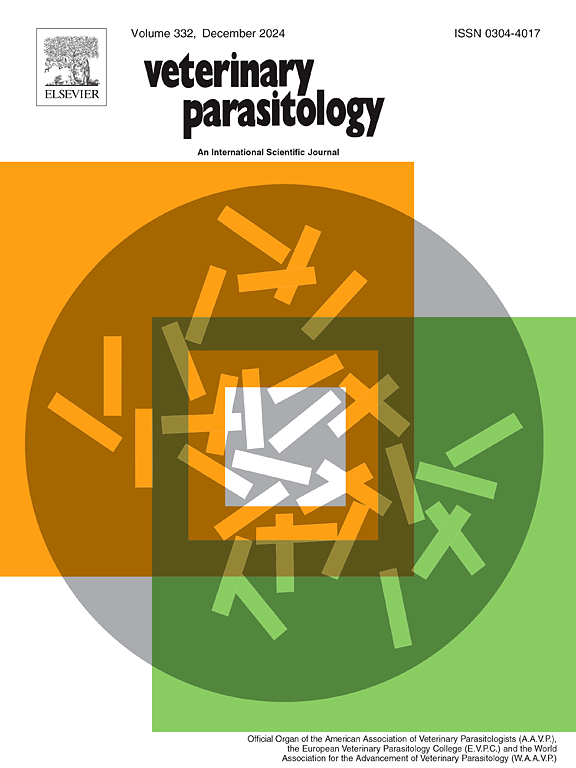Proteomic analysis of extracellular vesicles and extracellular vesicle-depleted excretory-secretory products of Toxocara canis and Toxocara cati larval cultures
IF 2
2区 农林科学
Q2 PARASITOLOGY
引用次数: 0
Abstract
Toxocara canis and Toxocara cati are parasitic nematodes in the order Ascaridida, which inhabit the small intestines of dogs and cats, respectively, as adults. Although often nonpathogenic as adults, nematodes within this genus are capable of causing widespread disease throughout the host while in a larval stage, during which time larvae migrate throughout the body in a process termed larva migrans. Larvae are also capable of surviving within host tissues in an encysted arrested stage, without immune clearance by the host. The ability of larvae to survive within host tissues during migration and encystment may be attributed to immunomodulatory molecules released by the excretory cells of larvae in excretory-secretory (ES) products. ES products of parasites contain a variety of molecules, including proteins, lipids, and extracellular vesicles (EVs). Toxocara excretory-secretory (TES) products have been studied to some degree, with proteomic analysis of TES proteins described previously; however, investigation of the EVs within TES is lacking, despite the suggested role for these molecules in host interaction and potential immunomodulation. To further characterize the protein cargo within EVs in TES, EVs were isolated from larval cultures of T. canis and T. cati via ultrafiltration, with concurrent collection of EV-depleted TES filtrate for additional study. Isolated EVs and EV-depleted TES from both T. canis and T. cati were submitted for proteomic analysis by liquid chromatography tandem mass spectrometry (LC-MS/MS). Proteomic identification results revealed 140 proteins across all samples, with 16 shared by all samples, and 76 total proteins shared between T. canis and T. cati, present within EVs and EV-depleted TES. There were 17 proteins shared exclusively by EV samples, and 15 were shared exclusively between EV-depleted TES samples. Many shared proteins were associated with the host immune response. Several proteins were specific to either T. canis or T. cati, highlighting the potential use of these proteins as diagnostic tools in the differentiation of etiologic agents in cases of toxocariasis. The results of this study build upon previously reported proteomic evaluations of TES, contributing new information in regards to newly identified proteins, EV protein cargo within TES, and potential immunomodulatory functions of these proteins.
犬弓形虫和猫弓形虫幼虫培养物细胞外囊泡和细胞外囊泡贫化的排泄-分泌产物的蛋白质组分析
犬弓形虫(Toxocara canis)和猫弓形虫(Toxocara cati)是蛔虫纲的寄生线虫,成虫时分别寄居在狗和猫的小肠中。虽然成虫通常不致病,但该属的线虫在幼虫阶段能够在宿主体内引起广泛的疾病,在此期间,幼虫会在体内迁移,这一过程被称为幼虫移行症。幼虫还能以包囊阶段在宿主组织内存活,而不会被宿主免疫清除。幼虫在移行和包囊期能够在宿主组织内存活,可能是由于幼虫的排泄细胞在排泄-分泌(ES)产物中释放了免疫调节分子。寄生虫的排泄分泌物含有多种分子,包括蛋白质、脂质和细胞外囊泡(EVs)。人们对弓形虫排泄-分泌(TES)产物进行了一定程度的研究,并对 TES 蛋白质进行了蛋白质组学分析;然而,尽管这些分子被认为在宿主相互作用和潜在免疫调节中发挥作用,但对 TES 内的 EVs 却缺乏研究。为了进一步确定 TES 中 EVs 所含蛋白质的特征,研究人员通过超滤从犬尾螨和猫尾螨的幼虫培养物中分离出了 EVs,并同时收集了去除了 EV 的 TES 滤液以进行进一步研究。犬尾狮尾狒狒和蝙蝠尾狒狒分离出的 EVs 和 EV 贫化的 TES 通过液相色谱串联质谱(LC-MS/MS)进行了蛋白质组分析。蛋白质组鉴定结果显示,所有样本中共有 140 个蛋白质,其中 16 个为所有样本共有,犬尾狮尾狒狒和猫尾狮尾狒狒共有 76 个蛋白质,存在于 EVs 和 EV-Depleted TES 中。有 17 种蛋白质为 EV 样本所独有,15 种蛋白质为 EV 贫化的 TES 样本所独有。许多共有蛋白质与宿主免疫反应有关。有几种蛋白质对犬蛔虫或猫蛔虫具有特异性,这表明这些蛋白质可作为诊断工具,用于区分毒蛔虫病病原体。这项研究的结果建立在之前报道的 TES 蛋白质组学评估的基础上,为新发现的蛋白质、TES 中的 EV 蛋白货物以及这些蛋白质潜在的免疫调节功能提供了新的信息。
本文章由计算机程序翻译,如有差异,请以英文原文为准。
求助全文
约1分钟内获得全文
求助全文
来源期刊

Veterinary parasitology
农林科学-寄生虫学
CiteScore
5.30
自引率
7.70%
发文量
126
审稿时长
36 days
期刊介绍:
The journal Veterinary Parasitology has an open access mirror journal,Veterinary Parasitology: X, sharing the same aims and scope, editorial team, submission system and rigorous peer review.
This journal is concerned with those aspects of helminthology, protozoology and entomology which are of interest to animal health investigators, veterinary practitioners and others with a special interest in parasitology. Papers of the highest quality dealing with all aspects of disease prevention, pathology, treatment, epidemiology, and control of parasites in all domesticated animals, fall within the scope of the journal. Papers of geographically limited (local) interest which are not of interest to an international audience will not be accepted. Authors who submit papers based on local data will need to indicate why their paper is relevant to a broader readership.
Parasitological studies on laboratory animals fall within the scope of the journal only if they provide a reasonably close model of a disease of domestic animals. Additionally the journal will consider papers relating to wildlife species where they may act as disease reservoirs to domestic animals, or as a zoonotic reservoir. Case studies considered to be unique or of specific interest to the journal, will also be considered on occasions at the Editors'' discretion. Papers dealing exclusively with the taxonomy of parasites do not fall within the scope of the journal.
 求助内容:
求助内容: 应助结果提醒方式:
应助结果提醒方式:


